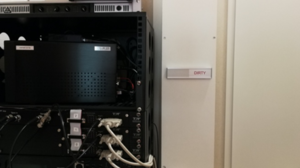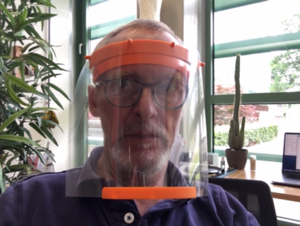COVID-19 Protocols for Biophysics Labs
Introduction
Here follows a description of the experimental protocols for the Biophysics researchers who carry out experiments with healthy human participants als well as participants from risk groups, e.g. those suffering from Parkinson's disease. The RIVM website describes what the risk groups for the novel corona virus are .
The experiments are carried out in the following areas of the Science Faculty:
- Basement W36A -2.002A: four labs (vestibular, visual, sphere and speaker arm)
- Basement W36A -2.002: NIRS-EEG lab
- Ground Floor HG00.823: Mini auditory lab
Existing Protocols
All existing experimental protocols regarding safety and research integrity for the different experimental setups are applicable also to the COVID-19 protocols. On top of that, the following additional COVID-19 related measures are in place.
COVID-19 Specific Measures
Anyone who deliberately violates the strict guidelines will be denied further access to the lab spaces until further notice.
- Participants and experimenters are questioned if they have had any Corona-related symptoms during the two weeks prior to the experiment. They should be entirely symptom-free, and to that effect report this on an informed consent form.
A sheet covering relevant triage questions can be found here.
- Mandatory hygiene instructions are written in the section Practical Hygiene Guidelines for Experiments with Human Subjects.
- An experiment can only be planned if there will be sufficient backup for technical support (at least one of the three technicians should be in the building), and for overall safety and medical-assistance backup provided by the BHV.
- Only experiments performed by PhD’s, postdocs, and master intern-students (as experimenters) will be allowed, not yet by bachelor interns. Later, if restrictions are more relaxed, we may also add the bachelor interns to this protocol.
- Personal contact should be avoided at all times.
- Admission to the labs is only allowed during formal office hours.
- Anyone entering the lab environment (experimenter and participant) is required to thoroughly wash and disinfect the hands. No gloves (clean hands are considered safer). Soap and alcoholic gel to that effect will be available at all times.
- In the laboratory measurement rooms, there is no more than one person during the experiment (typically, the experimental participant).
- When studies are carried out on participants from risk groups, additional precautions may be required:
- Participants can come with a companion or partner. The companion is one extra person in the lab if he stays with the participant all the time.
- It may make sense to receive the participant at less busy times, for example to avoid streams of students during breaks.
- No more than three of the experimental setups in A-2.002A can be used simultaneously at any given time. Thus, for the four setups, a maximum of 6 people is allowed in the lab space: three experimenters (available: 60 m2 open space) and three subjects for three setups (each ~10 m2 of space).
- In the NIRS-EEG lab (W36A-2.002) three people can be maximally present at any one time: two experimenters (in 40 m2), and one participant (in 15 m2 lab).
- In the Mini lab in HG00.823 maximally one experimenter and one participant (in the lab room; 7 m2) are allowed.
- Lab reservations should be made through the department’s QReserve reservation system. An experimental slot has a maximum duration of 2.5 hours, and there should be at least 20 mins between consecutive slots. These 20 mins are for cleaning and airing the lab space and cannot be used for lengthening an experimental session. Add some extra time if you expect to run out of time.
- After the experiment, the participant leaves the lab space as soon as possible, but the experimenter ensures a thorough clean-up and disinfection of all used materials (including the facial shields) and equipment. He/she indicates the status of the lab with the DIRTY/CLEAN switch.


- When a participant enters the lab, the switch must be set to “DIRTY”!
- The experimental device to be adjusted, and the table or chair for the participant, are thoroughly disinfected between experiments.
- In between experiments the ventilation systems are put on maximum power. During the experiment, the ventilation system is on, to ensure laminar air flow.
- On the long tables in the lab-spaces, in front of the setups, experimenters ensure a mutual distance at a minimum of 1.5 m.
- According to Q-portaal from the RadboudUmc, the following guideline is given: “bij een patiënt zonder (verdenking op) COVID-19 en wanneer er sprake is van een handeling waarbij de zorgverlener over langere tijd (> 3 min) zeer dicht (<30 cm) bij het gelaat van de patiënt komt, moet er een chirurgisch masker + spatbril of alleen een face-shield gebruikt worden.”
- If brief personal contact is unavoidable between experimenter and participant (e.g., to adjust a small device like an eye tracker or wrist- or head-band on the body/head of the subject), it can only be done while the experimenter has fully protected hands, torso, and head:
- he/she wears a clean lab-coat (short sleeves),
- he/she wears a personal facial shield (see below), and

- he/she extensive cleaned the hands and lower arms with soap prior to contact.
• The experimental device to be adjusted, and the table or chair for the participant, are thoroughly cleaned and disinfected between experiments. • The EEG and fNIRS caps should be cleaned with soap (which is considered the most effective virus-destroyer), and washed thereafter with luke-warm water. No alcohol cleaning of the electrodes.